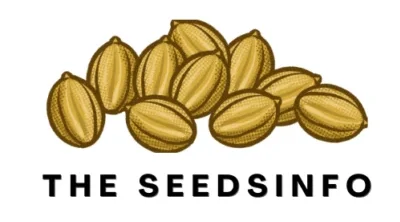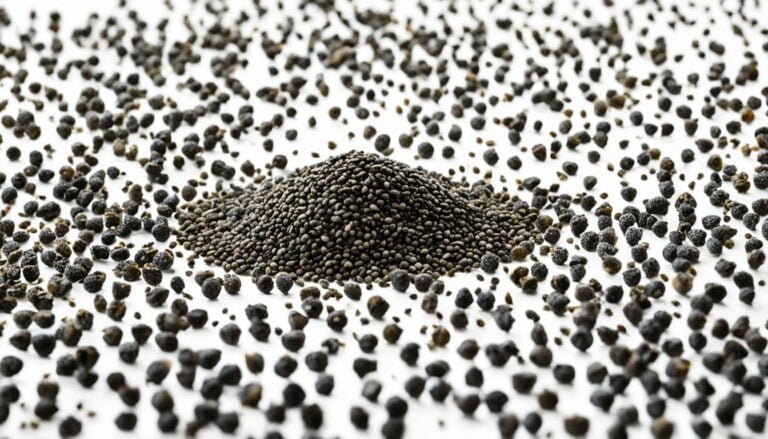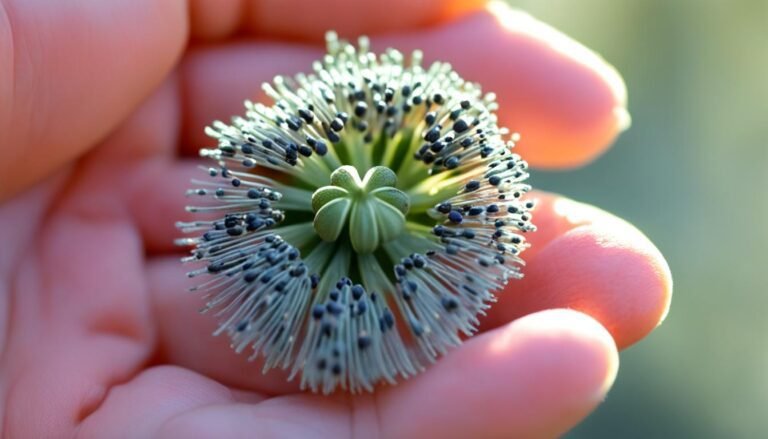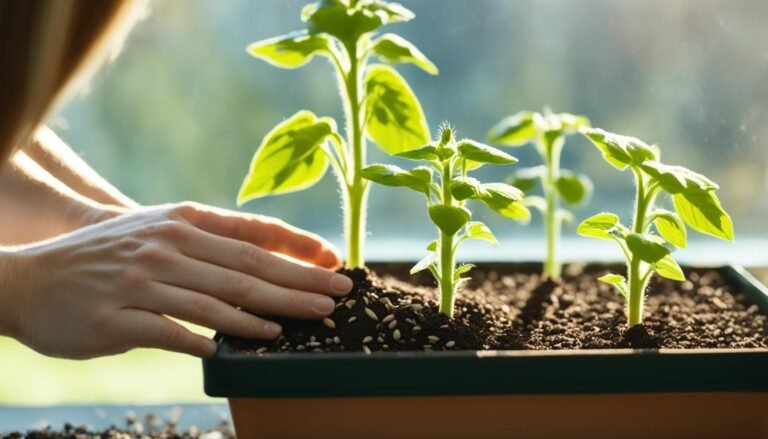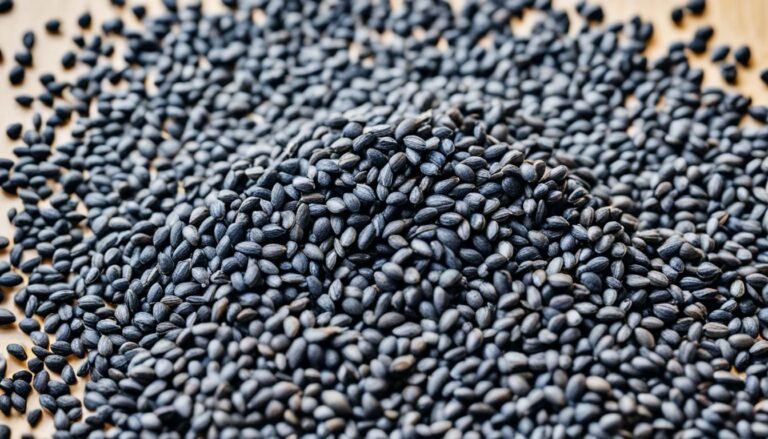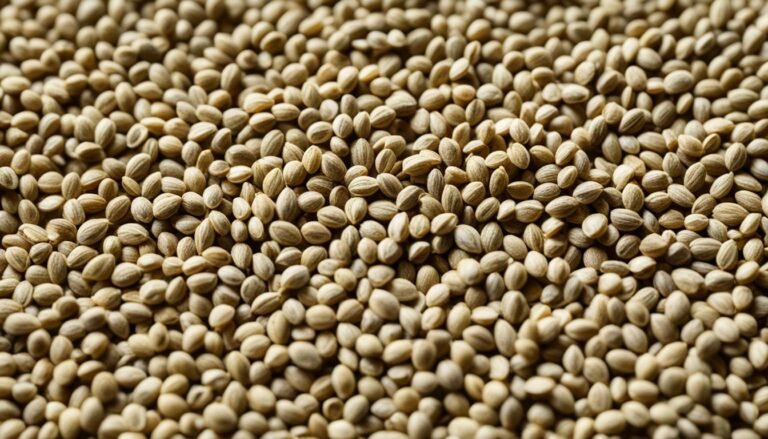Cinnamon Seeds: The Hidden Gem of Nature’s Spice Collection

Cinnamon is a spice we all know and love for its warm, aromatic taste. But there’s a secret within the cinnamon family – its seeds. These seeds are not as well-known as the bark, yet they hold a lot of potential waiting to be discovered.
Did you know that cinnamon seeds can help make your body more sensitive to insulin? This fact opens up a world of possibilities for cinnamon seeds. We’re going to explore the history, how to grow them, and their many uses. From cooking and health remedies to helping the soil and preventing diseases, cinnamon seeds are amazing.
Key Takeaways
- Cinnamon seeds have a lot of potential that’s often overlooked compared to cinnamon bark.
- They have a compound that helps improve insulin sensitivity, which is a big health benefit.
- This article will dive into the history, growing methods, and many uses of cinnamon seeds in food, medicine, and farming.
- Cinnamon seeds are great for improving soil health and keeping insects away naturally.
- Learn about the secret treasure in the cinnamon family and how to use this versatile spice fully.
Unveiling the Wonders of Cinnamon Seeds
Cinnamon seeds are small, oval fruits from the Cinnamomum trees. They have a unique flavor that’s different from cinnamon bark. They taste warm, slightly sweet, and a bit spicy. This flavor has made them a favorite in cooking around the world.
Exploring Nature’s Aromatic Treasure
Cinnamon seeds are hidden treasures in the Cinnamomum trees. They have a powerful aroma that can make any dish special. These seeds are not just for cooking; they are also good for your health.
They are full of antioxidants and can help control blood sugar and reduce inflammation. This makes cinnamon seeds a great spice for both cooking and health.
The Versatile Spice with Countless Benefits
- Ceylon cinnamon powder is rich in antioxidants, contributing to overall well-being and potentially reducing the risk of chronic diseases.
- Research suggests that Ceylon cinnamon may positively impact blood sugar levels, enhancing insulin sensitivity, especially useful for individuals managing diabetes.
- Ceylon cinnamon‘s anti-inflammatory compounds may help reduce inflammation, promoting better overall health and potentially aiding in conditions like heart disease and arthritis.
- Preliminary studies indicate that Ceylon cinnamon can improve cholesterol levels by lowering LDL cholesterol and maintaining or increasing HDL cholesterol, supporting heart health.
- Ceylon cinnamon exhibits antimicrobial properties, potentially aiding in fighting bacterial and fungal infections to provide an extra layer of immune system defense.
Discover the world of cinnamon seeds and see what this spice can do. Learn how to use it in cooking and find out about its health benefits. Start a journey that will change how you see and taste food.
cinnamon seeds: An Ancient Remedy Rediscovered
The use of cinnamon seeds in traditional medicine goes way back. In Ayurvedic and traditional Chinese medicine, these seeds were highly valued. They were used to help with digestion and breathing issues.
Today, we’re learning more about the beneficial compounds in cinnamon seeds. This has sparked a new interest in their healing powers. They are packed with antioxidants and anti-inflammatory properties. These help with blood sugar levels and heart health, proving the old wisdom right.
Research shows that just 1.5 grams of cinnamon a day can lower bad fats, cholesterol, and blood sugar. It also makes the body more sensitive to insulin. Plus, cinnamon seeds might help fight diseases of the brain and some cancers.
If you want to boost your health, manage a condition, or learn about cinnamon seeds, they’re a great choice. They offer a natural way to natural healing. As we learn more, people all over the world are embracing the benefits of cinnamon seeds.

Spice Cultivation: From Bark to Seeds
The journey from cinnamon bark to seeds is fascinating. It shows the blend of old traditions and new techniques in this spice. Cinnamon comes from the inner bark of trees in tropical areas. It needs special skills to grow and deliver top-quality products.
Tracing the Origins of Cinnamon
Cinnamon is known for its smell and taste. Its history goes back thousands of years. Most cinnamon sold in the U.S. is cassia, but the real cinnamon comes from Sri Lanka.
It has a unique tan color and taste. This makes it different from cassia, which is reddish-brown and comes from China, Indonesia, and Vietnam.
Harvesting Techniques for Premium Quality
Getting the best cinnamon needs careful harvesting. Growers must peel the bark and dry and process the seeds with precision. This keeps the spice’s aroma.
The bark is taken every two years, starting after the second year of planting. For young trees, the bark is peeled off. For older trees, it’s scraped out to make thicker quills.
Storing and handling cinnamon right is key to keeping its flavor and smell. Keep it in a cool, dry place, away from moisture, and date it for freshness. Too much air can make the spice lose its unique taste.
Cultivating cinnamon from bark to seeds shows the hard work and knowledge of growers. This ancient spice opens doors to new flavors and health benefits.
The Cinnamomum Trees: Guardians of Flavor
The story of cinnamon starts with the Cinnamomum trees. These evergreen plants are from Southeast Asia. They give cinnamon its unique taste. There are many types, like Ceylon cinnamon and Cassia cinnamon, each with its own flavor.
In 2021, the world produced 226,753 tonnes of cinnamon. China made 43% of it. Cinnamomum verum, or Ceylon cinnamon, is the real deal from Sri Lanka. Most cinnamon sold comes from four other types: C. burmanni, C. cassia, C. loureiroi, and C. citriodorum.
Knowing about these trees and how they grow is key for those who grow spices and love them. Each Cinnamomum type gives a special flavor. This makes cinnamon a versatile and exciting spice.

Cinnamon’s history is long and full of trade stories. Pliny the Elder said a pound of cassia could cost a lot, like fifty months’ work. In the Middle Ages, the West didn’t know where cinnamon came from. Venetian traders controlled the spice trade in Europe.
The spice trade changed over time. The Dutch set up a post in Sri Lanka in 1638. The British East India Company also played a big part in cinnamon’s story.
Today, cinnamon trees are grown for two years, then cut back to grow new shoots. This way, they keep producing bark. The bark is peeled, dried, and turned into the cinnamon we enjoy.
For spice lovers or those new to cinnamon, knowing about the Cinnamomum trees helps. It shows the depth and complexity of this spice.
Unleashing the Power of Cinnamon Seeds
Culinary Delights: Infusing Dishes with Irresistible Aromas
Cinnamon seeds are more than just a treat for your nose. They bring a unique flavor to many dishes, from sweet treats to savory meals. Their warm taste is perfect for adding depth to baked goods, sauces, and marinades.
Imagine making cinnamon-sugar cookies or adding cinnamon seeds to your oatmeal. Or, try them in a curry to make it extraordinary. Cinnamon seeds can turn simple dishes into something special. Get creative with them in your kitchen.
Natural Remedies: Harnessing the Healing Properties
Cinnamon seeds are not just for cooking. They have been used for centuries to help with health issues. People use them for everything from digestive problems to skin conditions.
- Anti-inflammatory properties: Cinnamon seeds have compounds that can lessen inflammation. This might help with arthritis or menstrual cramps.
- Digestive support: These seeds might ease digestive issues like bloating or stomach pain.
- Skin rejuvenation: Cinnamon seeds are used in skincare recipes to nourish and refresh the skin.
With more people looking for natural health solutions, cinnamon seeds are becoming popular. They can be used in cooking and as part of your self-care. Discover how these seeds can improve your health and well-being.
Spice Trade Secrets: Ceylon vs. Cassia Cinnamon
The spice trade has always been full of secrets. The difference between Ceylon cinnamon and Cassia cinnamon is one of these secrets. Both are in the Cinnamomum family but have their own unique traits.
Ceylon cinnamon comes from Sri Lanka and is known for its sweet taste and light color. Cassia cinnamon, from China, has a deeper aroma. Knowing the differences between these two is key for spice lovers and chefs. It greatly affects the taste of food and natural remedies.
| Characteristic | Ceylon Cinnamon | Cassia Cinnamon |
|---|---|---|
| Origin | Sri Lanka | China |
| Flavor | Delicate, sweet | Robust, intense |
| Color | Lighter brown | Darker brown |
| Coumarin Content | Lower | Higher |
| Price | Higher | Lower |
Cassia cinnamon is the most common type, with a rougher texture and darker color than Ceylon cinnamon. There are three types of Cassia cinnamon: Indonesian (sweetest and most mild), Chinese (strong, bitter flavor), and Saigon (intensely fragrant and flavorful).
Ceylon cinnamon is called the “true cinnamon” and is valued for its subtle flavor. But Cassia cinnamon is what’s usually sold as cinnamon in North America. It’s cheaper and easier to find.
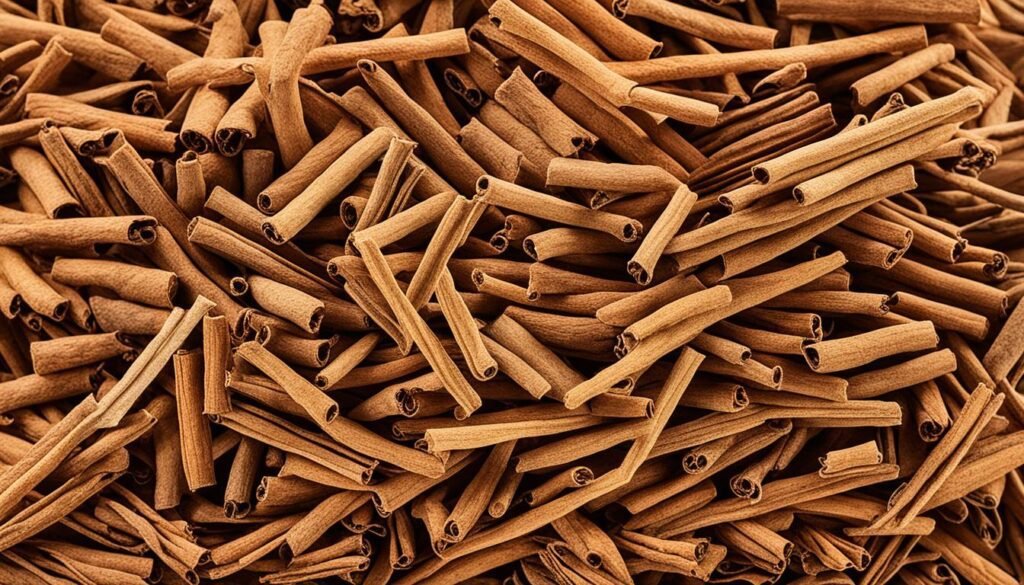
For chefs and home cooks alike, knowing the differences between Ceylon cinnamon and Cassia cinnamon can improve your cooking. It helps you make better choices in the spice trade.
Grinding Cinnamon Seeds: Unlocking Maximum Flavor
Grinding cinnamon seeds unlocks their true essence. By turning whole seeds into powder, you unlock their full aroma and flavor. Using a mortar and pestle or an electric spice grinder is key to preserving the oils that make cinnamon seeds special.
Freshly ground cinnamon seeds taste more intense and vibrant than pre-ground ones. They are a top choice for cooking and health. Studies show that spice grinding boosts flavor and freshness in recipes. Whole spices keep their aroma and strength longer than ground ones.
Choosing the right tool for flavor extraction is important. Mortar and pestle grinders give you control over the grind. Electric spice grinders are quick and easy for making fine powder.
- Mortar and pestle grinders offer precise control over the grind consistency for various recipes.
- Electric spice grinders quickly turn whole spices into fine powder.
- Freshly ground spices have more aroma and flavor than pre-ground ones.
- Whole spices can last years if stored right, while pre-ground spices may only last 6 months.
Proper grinding of cinnamon seeds is key to enhancing your cooking. By mastering spice grinding, you open up a world of flavors and aromas. This will make your dishes truly special.
| Spice | Flavor Profile | Optimal Grinding Method |
|---|---|---|
| Black Pepper | Pungent, earthy | Mortar and pestle |
| Nutmeg | Warm, slightly sweet, nutty | Microplane or rasp grater |
| Cardamom | Minty, citrusy, floral | Mortar and pestle |
| Sumac | Tart, lemony | Electric spice grinder |
| Star Anise | Licorice-like, anise-flavored | Mortar and pestle |
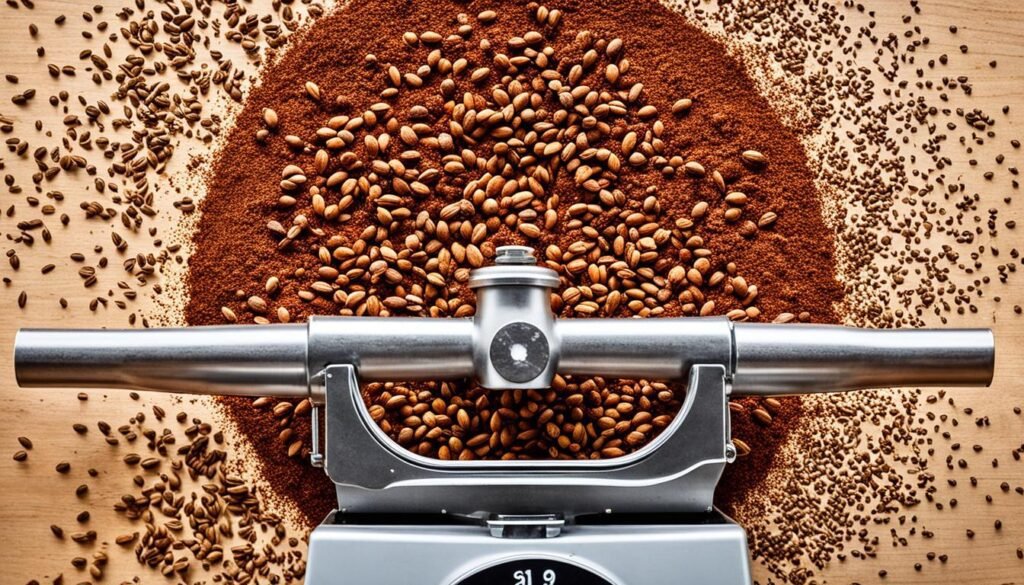
Aromatic Flavors: Elevating Dishes with Cinnamon Seeds
Cinnamon seeds are amazing because they go well with many sweet and savory dishes. They’re great for making cinnamon rolls or a savory spice rub. These seeds add warm, fragrant flavors to your food.
Sweet Treats: Cinnamon’s Perfect Pairing
Cinnamon seeds make baked goods and desserts taste sweet and comforting. They’re perfect for cinnamon rolls, pies, and cookies. These seeds turn simple treats into something special.
Savory Delights: Adding Depth and Warmth
Cinnamon seeds aren’t just for sweets. They can also add depth to savory dishes. They make spice rubs, marinades, sauces, and stews taste better. This adds warmth and flavor that makes dishes stand out.
Whether you’re baking pastries or seasoning a savory dish, cinnamon seeds are a great choice. They’re a culinary gem that can make your meals more delicious.
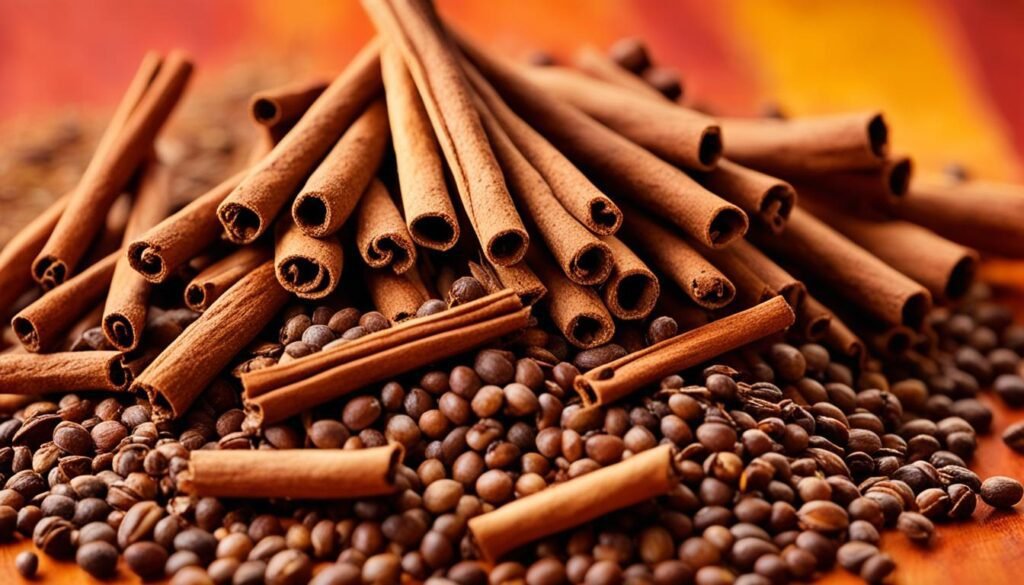
Sustainable Sourcing: Responsible Spice Cultivation
The demand for cinnamon seeds is rising, making it key to ensure they are grown and obtained sustainably. Responsible growers lead this effort, using eco-friendly methods that focus on soil health and water use. By supporting these efforts, we help make sure cinnamon seed production is ethical and good for the planet.
The spice market started in the Indian subcontinent about 2,000 BCE. It has faced many challenges, like low farmer earnings, harm to the environment, and quality issues. But, a move towards transparency and fair trade is helping fix these problems in the spice industry.
Ensuring we know where our spices come from is crucial. Supermarkets often handle spices many times before we buy them, making quality and ethics hard to check. But, local shops and companies focused on fairness and sustainability offer fresher spices with shorter supply chains. Companies like Diaspora Co, Curio Spice, Burlap and Barrel, Mala Market, and Rumi Spice are great examples.
| Sustainable Sourcing Practices | Key Statistics |
|---|---|
| Living Wage Validation for farm labor | Implemented by international sourcing partners |
| Crop rotation to promote soil fertility | Over 80% of sourcing partners use this practice |
| Direct engagement with growers | Over 90% of sourcing partners engage directly |
| Jobs supported through the supply chain | Approximately 1000 jobs |
| Use of natural water sources | All sourcing partners use rain, rivers, or wells |
| Sustainable management of land | Around 2000 hectares supported |
Supporting companies that grow cinnamon seeds responsibly is one way to help. You can also grow your own cinnamon seeds, use what you have before buying more, and buy from local farmers. These actions help the movement towards ethical and green spice use.
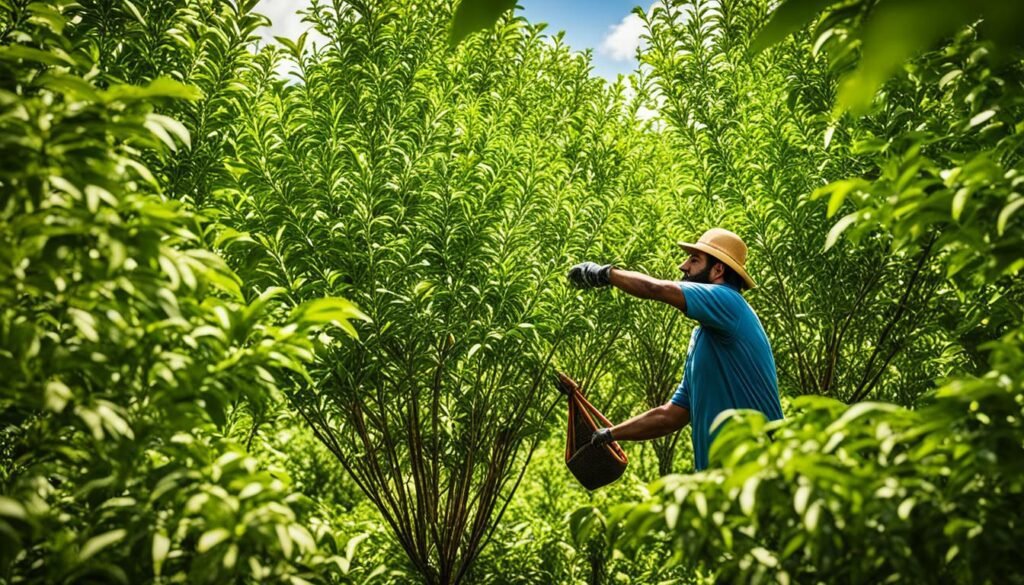
By choosing sustainable sourcing, we make sure cinnamon seeds and other spices are produced with respect for the environment and local communities. This approach also fairly rewards the farmers who work hard to bring us these spices. Together, we can create a future where enjoying cinnamon also means knowing it was sourced right.
Conclusion: Embracing the Magic of Cinnamon Seeds
Cinnamon seeds were once hidden in the shadow of cinnamon bark. Now, they are seen as a true gem in the spice world. These small seeds have a unique flavor and many health benefits. They can be used in both sweet and savory dishes.
By using cinnamon seeds, you can discover a world of aromatic delights. They are perfect for anyone who loves cooking, natural health, or just enjoys nature’s gifts. Cinnamon seeds have been used for centuries in healing and cooking.
They have moved from ancient healing practices to modern uses in culinary versatility and health benefits. This spice has shown its value over time and across cultures.
As you learn more about cinnamon seeds, think about sustainable cultivation. Supporting responsible farming helps keep this spice magic alive for the future. Let cinnamon seeds make your cooking better, improve your health, and fill you with wonder at nature’s gifts.
FAQ
What are cinnamon seeds and how do they differ from cinnamon bark?
Cinnamon seeds are small, oval fruits from the Cinnamomum trees. They have a unique taste that’s different from cinnamon bark. They taste warm, slightly sweet, and a bit spicy.
What are the health benefits of cinnamon seeds?
For centuries, cinnamon seeds have been used to treat many health issues, like digestive and respiratory problems. Today, science has found powerful compounds in them, making people interested in their healing powers again.
How are cinnamon seeds cultivated and harvested?
Growing cinnamon seeds needs special techniques, like carefully peeling the bark and drying the seeds. Harvesting them is done with great care to ensure they are of the highest quality.
What is the difference between Ceylon cinnamon and Cassia cinnamon?
Ceylon cinnamon comes from Sri Lanka and is known for its sweet, delicate taste and light color. Cassia cinnamon, from China, has a deeper aroma. Knowing the differences between these two is important for spice lovers and chefs.
How can cinnamon seeds be used in cooking and natural remedies?
Cinnamon seeds are versatile and add a warm, sweet flavor to many dishes. They’re also used in natural health remedies because of their potential health benefits.
What are the best practices for sustainable sourcing of cinnamon seeds?
Responsible farmers focus on eco-friendly farming to protect soil, water, and ecosystems. By choosing sustainable sources, we help ensure cinnamon remains available for the future.
